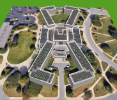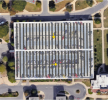Engineers for a Sustainable World team participates in first-ever National Solar District Cup

ESW team members Clayton Markham and Henriette Zombori (second row) presented their design to a panel of solar industry professionals via zoom. The presentation, which would have been part of the Solar Power Southeast Conference in Atlanta, GA, was moved online due to the coronavirus pandemic.
By Nicole Capozziello
Published July 28, 2020
When Clayton Markham heard about the Solar District Cup, a new competition by the U.S. Department of Energy, it seemed too good to be true.
Markham, an incoming junior in environmental engineering and a member of Engineers for a Sustainable World (ESW), had been looking to apply the skills he’d gained during his freshman year in SEAS – and to learn more about the field of renewable energy in particular. So, at a fall ESW meeting, he presented the competition to fellow members as a project for the 2019-2020 school year.
“The Solar District Cup was a bit of a different twist for ESW, which is traditionally a club based around campus-centric projects,” says Markham, the team captain. “However, our team still embodied the same mission as all the other project teams in ESW, which is to bring students together from a wide array of disciplines and interests to solve issues surrounding the environment and sustainability.”
For the competition, which is administered by the National Renewable Energy Laboratory (NREL), student teams were assigned an urban district or college campus for which they were asked to develop a solar photovoltaic (PV) plus battery storage system, maximizing energy offset and cost savings. They created a report detailing: 1) conceptual system design, 2) distribution system impact analysis, 3) financial analysis, and 4) development plan.
The University at Buffalo team was assigned Ball State University, a public research university of about 22,500 students in Muncie, Indiana. They were given access to information specific to Ball State such as kWh consumption of the buildings on campus and the university's utility rate structure, as well as free access to software and online instructional assistance, allowing students from any starting experience level and background to be able to participate.
Comprised of students from across the School of Engineering and Applied Sciences, the UB team was one of 61 teams, from 52 colleges across the country, to participate in the initial round of the competition. Their deliverable report was due on November 21 and was reviewed by competition organizers.
The team was one of 35 selected to progress to the final round, getting the opportunity to refine their design over the spring semester. For the final phase of the competition, they were also asked to add a battery storage component to their design.
While the Solar Power Southeast Conference in Atlanta was cancelled due to the coronavirus crisis, the team was still able to deliver their final presentation over Zoom on April 26, presenting to a panel of judges made up of solar industry professionals.
Though their design was not the chosen winner for the Ball State University district use case, the team was proud of their accomplishments, particularly since the Solar District Cup competition was intended for upperclassmen and their team was made up of freshmen and sophomores.
“I could not be more pleased with how much newfound knowledge I took away from this competition on the whole process of renewable energy consulting projects, from initial site assessment to the final construction timeline,” says Markham.
“Whether I find myself making a career out of solar energy consulting or not, I gained and honed many translatable skills in managing a team, communicating both in person and in a pandemic, teaching myself about foreign topics and how to use new software, and delivering both written and oral presentations.”
In addition to Markham, the other team members were: Jesse Dugan, environmental engineering ’22; Dylan Sandler, aerospace engineering ’22; Rajat Wagh, electrical engineering ’23; Steven Moskaluk, mechanical engineering ’22; Euclid Jenne Fortin, biomedical engineering ’22; Jessica Paskie, environmental engineering ’22; Jacob Pompeii, environmental engineering ’23; and Henriette Zombori, civil engineering and geological sciences ’22.
The team also received help and mentorship from Austin Izzo, a master’s student in the Department of Civil, Structural and Environmental Engineering, Hailie Suk a doctoral student in the Department of Mechanical and Aerospace Engineering, Cody Kowal (BS, electrical engineering ’20) and Alex Marusewski (BS environmental engineering ’20).





